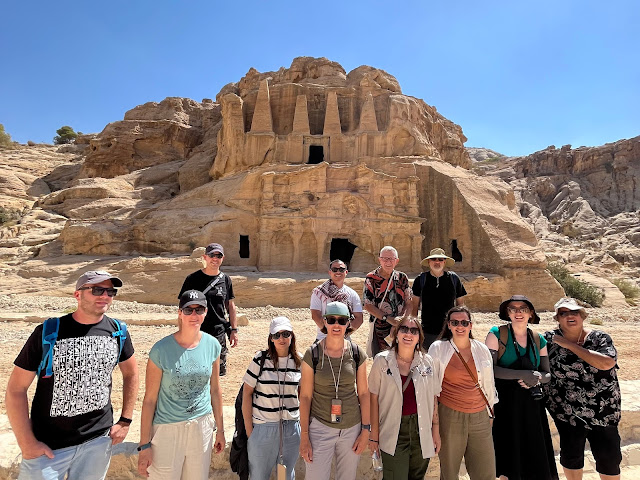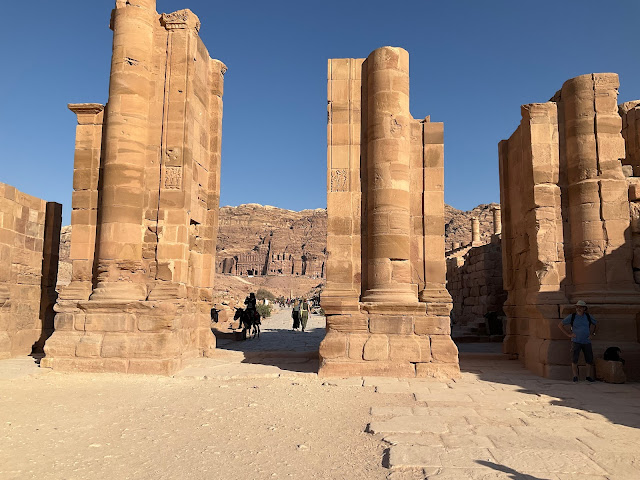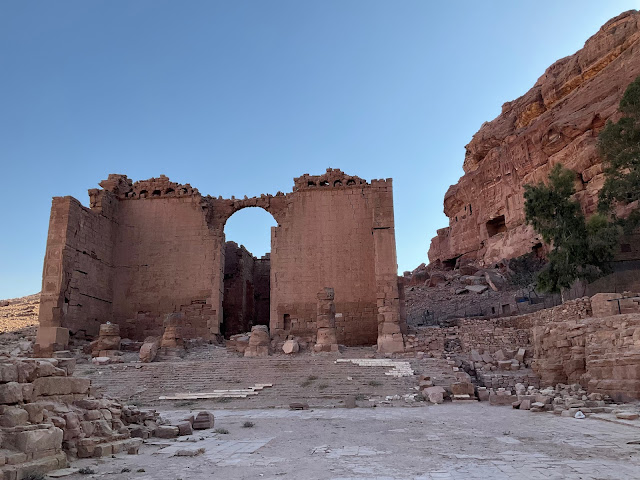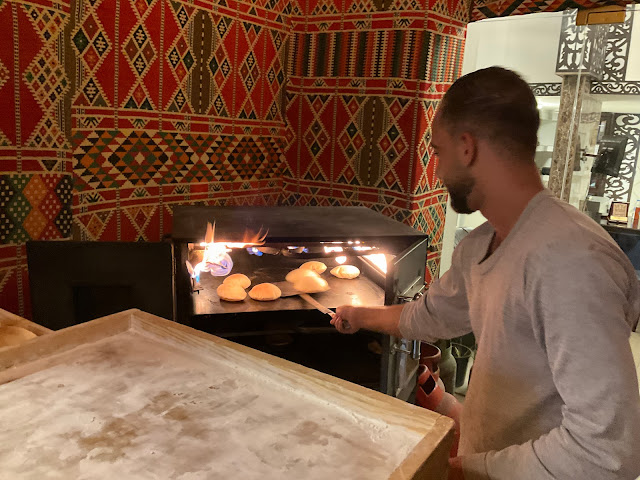Once we left the Wadi Rum area, we found our two-hour drive to Petra, was marked with curving roads over mountainous territory with only green vegetation around the small villages we passed.
Petra Treasury
On the way into Petra, we stopped at an overlook to view the town below and the surrounding territory. We also took a short stop at a bakery, which I thought would have pastries but instead, it had some pita pizzas. I had one that had toasted sesame seeds and cumin with some garlic, and it was delicious.
We were pleased that we were going to be staying at a brand new Petra Icon Hotel, even though it did not have a pool. Mathew was again my roommate.
For our first afternoon, Musa, our guide would walk us through the entire area and give us a bit of historical information and then the following day we would be on our own to explore some of the other sites that we did not hike up to, or that we wanted to explore further.
We learned that Petra was relatively unknown until 1812 when it was visited by Johan Burkhart— a Swiss explorer. In 1985 UNESCO recognized it as a World Heritage site.
Although our admission pass would’ve allowed us to ride a donkey down to the entrance of the Canyon area, we chose to walk.
We first passed by the Djinn Blocks area with its big sandstone blocks along with the Obelisk Tombs where Musa once again had us do a group photo before proceeding to the mile-long Siq which was a narrow gorge formed by the movement of tectonic plates and not a river like many canyons.
Throughout this Petra site, there are more than 800 registered sites including 500 tombs. Near the end of the Siq, we came across the opening of the narrow gorge, where the carved-out Treasury was— also known as Al Khazna. Most of the construction and tombs were built and carved out of sandstone by the Nabataeans during the 1st century BCE.
The Treasury is over 130 feet high and intricately decorated with Corinthian capitals, friezes, figures, and more. The Treasury is crowned by a funerary urn, which, according to local legend conceals a pharaoh's treasure. The Treasury is the most photographed image of Petra, and we were lucky that the crowds were not so big.
While, at the Treasury, we saw a Palestinian demonstrator with a Palestinian flag, who was getting beat up by the camel drivers until the police intervened and took the demonstrator away in a paddy wagon. It’s apparent the camel drivers were concerned that this demonstrator was chasing away tourists and their livelihood.
Once again, Musa took a group shot of us in front of the Treasury before we proceeded on down to the end of the main areas of Petra at the Qasr al-Bint.
We stopped at the Theater. That was one of the only theaters that was dug out of stone, and later, the Romans expanded it when they took over the area. The Romans also built the Byzantine church that was above the Colonnaded Street and was also built by the Romans.
The Royal Tombs were across from the Theater, and some of us would visit those tombs more closely the following day.
As we came to the end of our guided tour with Musa, we stopped at the Great Temple, and the Qasr al-Bint which was dedicated to Dushara by the Nabataeans as a pre-Islamic Arabian god who was expected to bring justice, if called by the correct ritual.
We then made our way back to the hotel to freshen up before having dinner at the hotel buffet restaurant.
I had planned the following day to get up early to head up to the monastery in Petra, along with other hikes by getting breakfast at 6:30. However, I ended up on the phone with Turkish Air to change my flight plans to leave immediately following the tour back home instead of returning back to Egypt for a week and then flying home.
I was successful in getting my Turkish flight changed to leave from Amman, Jordan instead of Cairo, a week earlier, but it came with a plane change fee of $540 USD. I was able to cancel my Hostel reservations both in Jordan and in Egypt for no charge. With my flight from Amman to Egypt. I was able to get a partial refund except for $40 USD. When I get home, I may end up filing with Travelguard for reimbursement on the $540 USD. Update: Travelguard rejected my claim because the policy has a "war" exclusion for approving claims.
With the tensions over the war between Israel and Hamas, I was continually getting messages from home that I should cut my trip short because people were worried that I may be in danger of injury or getting kidnapped. People in our group suggested that I may want to stay in Jordan for my last week in the Middle East instead of returning to Egypt.
Now that things were settled for my return home. I headed out with Matthew to explore the Petra UNESCO site on our own.
At the entrance to the Siq, Matt and I came across this group of Roman soldiers in ancient gear, doing some marching about.
We then headed directly to the trail that led up to the monastery with some 800 steps and took an hour starting near the Qasr al-Bint and the camel and donkey corral.
On the way up, we passed several vendors, and with a few of them, I indicated that I would be coming back down and looking over their stuff. Both Sarah and Turquoise remembered my comment and I ended up buying some trinkets from them for my grandson.
At the beginning of the monastery trail, we saw they had used some of the caves to park their vehicles.
On the way up, we saw both Sabine and Thorsten who were coming back down.
The Monastery was even taller than the popular Treasury at 159 ft., and it was much less crowded—I guess that’s what more than 800 steps up will do for crowd control.
It was built in the third century BCE as a Nabataean tomb. Later it was used as a church during the Byzantine era where crosses were carved on the inside walls, and it is why it is now referred to as a monastery.
When we got to the Monastery—Ad Deir, we met up with some of our other Intrepid tour members—Dan, UK Nick, Morgan, Lien, Daniela, and Sandra.
We had a good rest and a view of the Monastery as we ate and drank some treats from the nearby cafe.
We all headed back down to a restaurant at the end of the Colonnaded Street. After lunch, Nick, Lien, and Morgan decided to hike up to the High Place of Sacrifice while the rest of us returned to our hotel.
Dan and I stopped at the Byzantine Church on the way to admire the mosaic tiles that were well preserved while the others continued on.
I looked at the Royal Tombs on the way back, but I did not take the trail up to check them out more closely--800 plus steps up and down earlier dissuaded me from leaving the trail back to the entrance of the Petra, Capital of the Nabataeans.
After we got back to the hotel, three of us went for our Turkish Baths. Here they segregate the bath and massage treatments by sex.
I changed into a red swimsuit they provided and spent about 1/2 hour in the steam room where I could hardly see my hand in front of me.
After that, I entered the massage room area which was warm and had a granite bench for me to sit and later lie on. The first phase was to wash me off while sitting. After that, I laid face down on the granite bench, when two guys began sudsing me up and massaging me with some rough gloves—I think I lost a layer of skin when they did that.
Even when rinsing the soap—and dead skin—they continued to massage me. Afterward, I felt like a limp rag.
We returned to the hotel and joined up with others to dine at a rooftop restaurant nearby.
On the way in I talked to the fellow that was cooking the pita bread and he gave me a piece to enjoy and I caught up with the others.
While waiting to be served, we had another Musa group photo op.
During our time in Wadi Rum and Petra, I and most others walked over 10 miles per day to experience these amazing sites.
We left Petra the following morning to experience floating in the Dead Sea, some 1,312 feet below sea level which has been lowering every year as evaporation is more loss of water than the Jordan River provides. As you walk down to the Dead Sea you see several signs that show the sea level with the date starting in 2005.
Subscribe to my YouTube Channel
I have recently uploaded all of my travel videos to YouTube now that they allow longer uploads. I have also added other shorter travel videos.
That link is https://www.youtube.com/c/huntforgold
If you do go there, please subscribe to my video channel since it will help me eventually get some income there and help with my future travels. Fewer people are using DVDs so I am transitioning to streaming my travels on my YouTube channel.






















































